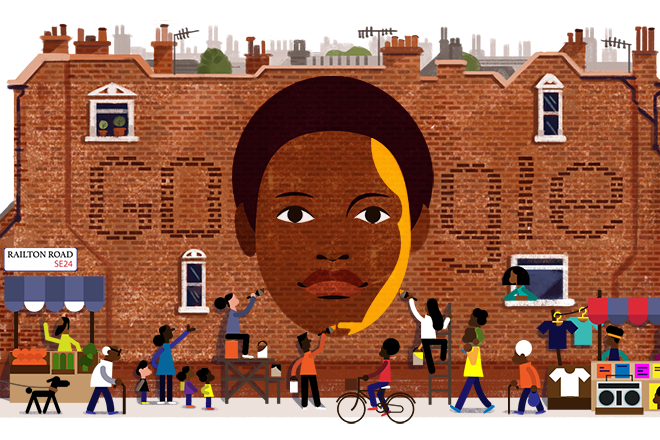Olive Morris: Google Doodle honours activist who campaigned to improve the lives of the black community
Olive Morris, who died of cancer at the age of 27, would have turned 68 on Friday 26 June, writes Sabrina Barr


Your support helps us to tell the story
From reproductive rights to climate change to Big Tech, The Independent is on the ground when the story is developing. Whether it's investigating the financials of Elon Musk's pro-Trump PAC or producing our latest documentary, 'The A Word', which shines a light on the American women fighting for reproductive rights, we know how important it is to parse out the facts from the messaging.
At such a critical moment in US history, we need reporters on the ground. Your donation allows us to keep sending journalists to speak to both sides of the story.
The Independent is trusted by Americans across the entire political spectrum. And unlike many other quality news outlets, we choose not to lock Americans out of our reporting and analysis with paywalls. We believe quality journalism should be available to everyone, paid for by those who can afford it.
Your support makes all the difference.In the 1970s, activist Olive Morris became an influential voice for the black community in the UK, using her platform to speak out against the injustices and discrimination black people faced.
Born in Jamaica on 26 June 1952, Morris and her family emigrated to London when she was nine years old.
Leaving school without qualifications, the young crusader became a staunch champion for her community, fighting against police brutality; campaigning for better education and living conditions for black people; and travelling the world, using her experiences to inform her domestic activism.
But at the age of 27, Morris died after being diagnosed with non-Hodgkin lymphoma.
On what would have been her 68th birthday, Google Doodle has paid homage to the community leader with an illustration that depicts her face being painted onto a mural on Railton Road in Lambeth.
The street in south London bore particular significance in Morris’ life, as it is where she helped to create a hub for members of the black community.
In her short life, Morris worked tirelessly to fight prejudice and to create meaningful change.
The early days of activism
One of the earliest examples of Morris’ activism occurred in 1969, when Nigerian diplomat Clement Gomwalk was attacked by police officers in Brixton.
Not believing Gomwalk when he said that he was a diplomat, the police proceeded to beat him in front of a crowd of onlookers.
While one journalist’s account from the day claimed that Morris “broke through the crowd to the scuffle” and “tried to physically stop the police from beating the Nigerian”, Morris reportedly later stated that she did not arrive at the scene until Gomwalk had already been taken away by the police.
However, Morris received brutal treatment from the police, being taken into police custody, forced to strip and threatened with rape.
In the article “Finding Olive Morris in the Archive”, published in the journal The Black Scholar, scholar and historian Tanisha Ford wrote about how she came across a transcript of an account Morris gave about her experience in 1970, “shortly after she was brutalised and threatened with rape by the London police”.
“It elucidated the forms of sexualised terror black women have suffered at the hands of law enforcement and challenged the black masculinist framing of police brutality,” Ford stated.
In the Oxford Dictionary of National Biography, it states that Morris was charged with “assault on the police, threatening behaviour, and possession of dangerous weapons”. The 17-year-old was fined £10 and given a three-month suspended sentence for two years.
Carrying her voice into the 1970s
Following her violent treatment at the hands of police officers, Morris continued her campaign to combat systemic racism in the UK, joining the British Black Panther Movement in 1968 and going on to become a founding member of the Brixton Black Women’s Group in 1974, one of the first networks for black women in Britain.
She also became a founding member of the Organisation of Women of African and Asian Descent, in addition to continuing her activism work in Manchester while studying for a degree in social sciences between 1975 and 1978.
On Remembering Olive Collective, a blog dedicated to raising awareness of Morris’ life, it says that she “campaigned for access to education, decent living conditions for black communities and fought against state and police repression”.
“Despite dying at a young age, she empowered the people who lived and worked around her,” the blog states.
In 1973, Morris and fellow activist Liz Obi squatted at a building located at 121 Railton Road in Brixton, the road depicted in today’s Google Doodle.
The building became a hub for political activism and community meetings, in addition to providing a black community bookshop called Sabarr Bookshop.
Gender equality and women’s rights charity The Fawcett Society explains the influence Morris’ squatting had, stating that “according to [civil liberties campaigner] Darcus Howe’s biographers, Robin Bunce and Paul Field, Olive was a woman who turned squatting into an art form”.
“In honour of that skill set, Olive is photographed scaling the wall of a house on the front cover of the Squatters’ Handbook,” the charity adds.
In 1978, Morris became ill while abroad in Spain. After returning to the UK, she was diagnosed with non-Hodgkin lymphoma, a rare cancer that develops in the lymphatic system.
Following unsuccessful treatment, Morris died at St Thomas’s Hospital in Lambeth on 12 July 1979 when she was 27.
Her legacy
In 2015, Morris was selected to appear on the Brixton Pound, a currency used solely in Brixton alongside pounds sterling to support local business.
Four years prior, the Olive Morris Memorial Award was established to provide bursaries for young female black activists, named after “one of the country’s top civil rights heroines”.
In 1986, seven years after her death, Lambeth Council elected to name one of its buildings after her.
Olive Morris House, which is situated on Brixton Hill road, is due to be demolished and redeveloped as part of Lambeth Councils’s “New Town Hall” project.
Join our commenting forum
Join thought-provoking conversations, follow other Independent readers and see their replies
Comments